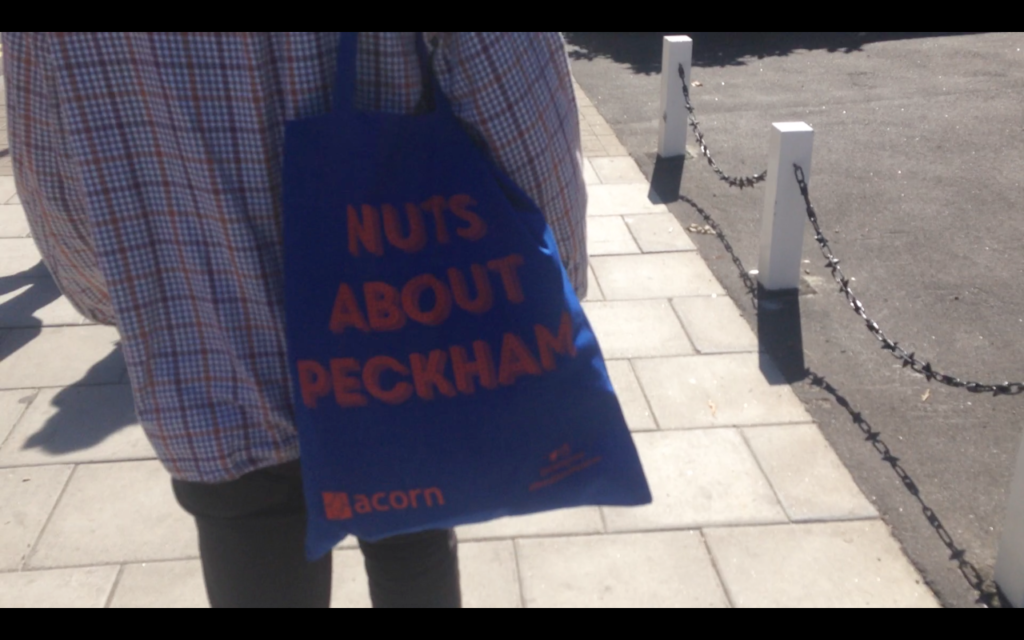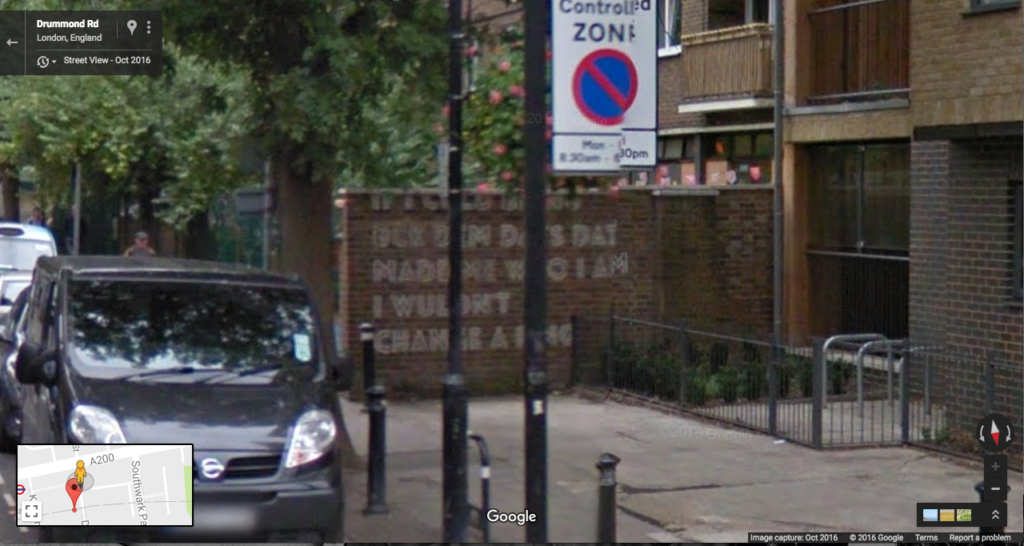Community Projects
A blue canvas tote reads ‘Nuts About Peckham’ in red screen print. It swings from side to side with each step forward. Keys clink against a phone or something similar inside. I’m here as a tourist, more so than when I lived here as a student, and I’m filming a man in front of me walking up the high street, because both of us are carrying the same blue bag. Today is the inaugural Peckham Festival, running September 8 to 11, sponsored by local Acorn Estate Agents, whose free merchandise I am paying for in my co-opted labor as an ad campaign. It’s a weekend-long event across new and established businesses, creative organisations, community groups, restaurants and bars in the south-east London suburb. The bags contain flyers and a stapled, colour printout of some of Acorn’s properties available to buy or let. This kind of strategic marketing hangs awkwardly over a 20-something-artist in Peckham’s shoulder. A heavy token for the indirect cultural contribution to the market value of property in the area. In the past decade especially, the largely working-class multicultural area of Peckham has gained international recognition within the art world and beyond for its creative output. With a range of practices, motivations and organisational models, young artists have moved to the area with increasing frequency to forge new localised networks nurtured by nearby educational institutions; Camberwell College of Art and Goldsmiths University. A previously neglected inner London suburb, Peckham was known to a British television audience through two brothers’ unsuccessful economic ambitions in Only Fools And Horses which ran on the BBC until 1991. Its early-noughties realities of cheap rent, vacant commercial buildings and flexible private landlords offered creatives access to Peckham’s property rental market.

Several blocks west of the municipal high street amenities of Rye Lane, lies Bellenden Road, a locale that emerged in the latter part of the 00s as a humorously named exemplar of gentrification in Peckham (see here for the translation of the anatomical British slang word ‘bellend’). In 2001, Bellenden Renewal Area, a scheme organised by Southwark Council, encouraged regeneration to happen locally by involving traders and residents with as few outside contractors as possible. The project included community-initiated commissions by several established local artists and included murals, customised pavement stones, railings, lampposts etc.; the most notorious of which were a set of aptly phallic bollards by artist Antony Gormley that now lines the area’s small streets. Southwark Council saw the concentrated regeneration plans of the area as a prototype for communally-driven regeneration initiatives.
Bellenden Road was also home and studio to John Latham. The late artist’s former residence at number 210, more recently known as Flat Time House, closed its doors to the public earlier this year. In 2003, several years before his death, Latham declared the property a living sculpture. In 2015, his estate was no longer able to fund the project and a failed crowdfunding attempt to buy the property forced the Flat Time House organisation to vacate in July 2016 with plans to continue in the future in a different format. The public legacy of both this artist’s practice and the Flat Time House programme, we can assume will become a point of provenance on the market as the living sculpture returns to real estate.

Buzz Killers
In the City of London’s beating heart, a room in a former office building on Holborn Viaduct becomes the previously Mayfair-based commercial gallery space Project Native Informant’s new home. Current Affairs, Georgie Nettell’s third exhibition at the gallery, which ran from September 29 to October 29, displayed a series of foam-mounted and framed photographs. The images referred to recent moments in the English capital; topical subjects that ranged from post-Brexit politics to the tales of London’s gentrifying business-folk. They were social-networked in-jokes to some, seemingly neutralised cosmopolitan images to others. The exclusivity of the (assumed) specific gallery community that Nettell’s work is displayed to is codified into the compositions subjects, as a sub-community with a stake in the mechanism of the creative gentrifiers, establishments and political affairs referenced.
The works, as described in the press release, were photographs shot ‘phone-to-screen.’ A row of well-kept London terraces is the home of new UK Foreign Secretary, Boris Johnson, a key figure behind the recent Brexit campaign for Britain to leave the European Union. An interior from Brick Lane’s Cereal Killer Cafe, selling imported cereals with a price tag of £3.50 a bowl, was subject to attacks by anti-gentrification protesters and interrogating reporters on live TV. Current Affairs trips itself out as a quasi-urban-renewal Community Centre for the creative industry worker who priced themselves out of an area.
The gallery itself feels aesthetically rough around the edges, like an artist-led project space or live/work studio. The interior and images infect one another’s registers against a view of the city from the gallery’s third floor windows. IKEA desks and a bookshelf are used to delineate gallery from office. The room is lit with fluorescent tubes in recessed ceiling tiles that may have been upgraded daylight bulbs. The interior feels fashionable in its arbitrary features. As a cafe-bar might leave a section of unpainted drywall or exposed brick, the ex-city-centre office bares an environment fitting for Nettell’s show and her subjects. The Current Affairs press release refers to the function of these images as logos for a creative-cultural demographic and the ethical issues around them. Eating a gourmet burger at a chain that conspires with the police to trick and arrest suspected undocumented workers, and smashing up a Foxtons estate agents are both experiences rife with questions of privilege, access and community. These images, in their simplification as signs, critique the viewer demographic and their brand of judgement but do so from within the safe space of a young, successful, commercial gallery where these critiques are the artist’s content and commodity.

Remember The Good Old Days?
If you walk along Drummond Road near Bermondsey Tube Station in South London, there is an incognito relic of artistic activity to look out for. It marks the location of a doctor’s surgery that previously inhabited the site of number 6 to 8, which became the second incarnation of The Woodmill. The artist-led charity rented the space between 2012 and 2014 to continue their Bermondsey-based project of affordable studios, residencies and exhibitions. Two years later the space was sold to developers, demolished and replaced with new flats.
In December 2013, the group commissioned Ilja Karilampi to produce a work across the two external brick walls within the foyer of the former surgery. ‘Medulla Oblangata‘ was stencilled in fluorescent paint illuminated by UV light; a text that the artist’s website called “a sentence based on Wiley lyrics, translated to SMS slang by the local youth.” The work across the two walls read “If I culd bring bck dem days dat made me who i am i wuldnt change a fing coz all the fings in my past created who im ment 2 b.” [sic]. When The Woodmill group left the site early the following year, Karilampi’s work was left behind with the assumption that it would be demolished, along with the rest of the building. What wasn’t predicted was what happened during the construction work. The left-hand-side dividing wall with the Berlin-based artist’s text was retained as an external feature to the new housing development; a gesture towards authenticity on the facade and entrance to the new flats. No one was contacted about this plan to incorporate the former artwork into the design of the new building.
Looking at the wall now on Google street view, the text reads “IF I CULD BRING BCK DEM DAYS DAT MADE ME WHO I AM I WULDNT CHANGE A FING.” Re-authored by the development as something in public view, its function and intention is a skewed addition to the expected paving, flowerbeds and bike racks that one would find in the yard of an inner-city new development. The text wall, in its urban authenticity, violently co-opts multiple layers of identity politics and signification; of the artist’s intent and co-option of local young residents’ re-coding of song lyrics, Wiley’s artistic influence within London’s music and youth cultures and the developers mis-identification. It’s an interesting situation that merges artistic capital into property and re-development with the aim to quickly and efficiently produce something real and experiential but without any specific relation to the context or its histories. An empty slogan for a nonspecific relationship to community, the wall is forced into its second life as nostalgia, with the propagandist sentiment of a ‘Keep Calm and Carry On’ poster.

Public Spaces
In October 2016, South London Gallery opened a new public garden to the rear of their main gallery. Designed by Mexican artist Gabriel Orozco, in collaboration with 6A architects and Kew Gardens, the project connects the Victorian Peckham Road institution to its residential neighbours with a new gallery entrance from the longstanding Sceaux Gardens Estate.
The garden looks digitally-generated in its layout but was produced by manual, human labor. Several tiered cylindrical basins are designed to become temporary ponds when it rains and also irrigate the new plant life. A box fresh, impersonal materiality of York stone brick, grafted flowerbeds and freshly cured cement keep you firmly, for now, in the experiential realm of the regeneration aesthetic. As you walk away from the gallery, the new pathway slopes down between two rows of Council bungalows that architecturally are at odds with the contemporary design ideologies in use by 6A. Crossing the threshold of an iron gate, Orozco’s flowing bricks come to a halt and the Council Estate paving resumes.
Opening at the same time as Orozco’s garden, in the main gallery space of SLG, Slovakian artist Roman Ondek had a section of the slatted floorboards removed as part of his solo exhibition. It reveals a preserved central inlaid wooden floor from 1891. The central panel reads “The source of art is in the life of a people.” In contrast, as Ondek reveals a floor, Orozco lays one. The latter collaborates with an art institution and architects to bring a specific system of an artist’s identity to a public space connecting a housing community and an art gallery. The former reminds a community — read, a specific labor community of the institution’s workers — of its role as a group responsible to a notion of a people and a public.

***
Reflecting back on the Bellenden Regeneration Area project from 2001, that part of Peckham was given a unique opportunity to redevelop its streets with public money in a way that wasn’t possible to offer or apply to every borough of London. The project’s community-generated development, with an emphasis on localism, allowed a proportion of the people who would feel the changes to also be influencing them, and to communicate with the creative community presence in the area.
Fast forward back to 2016, and Peckham is increasingly inaccessible, pricing-out its low-income households, artists and businesses. Council properties are regularly sold off on the private market to go on to be developed for profit with the council’s sale capital put into large-scale future contracted re-housing projects. With the recent overground rail line extensions’ regular services between Peckham Rye and the north and the east of the city, Peckham has become more accessible to workers on higher incomes, drastically increasing the rental and property values. These shifts were absorbed into the Acorn Estate Agents investment in the Peckham Festival event. The blue canvas tote bag that celebrated and reflected a new locale felt like a false flag for a faceless ideology of change that no one party can be designated as responsible for but we all commune within.**













